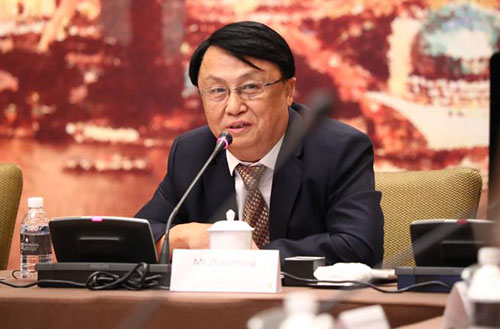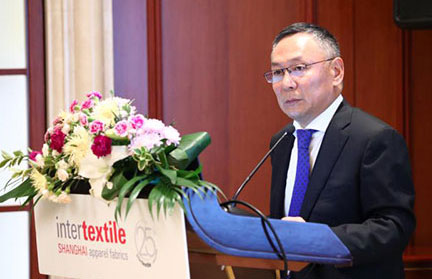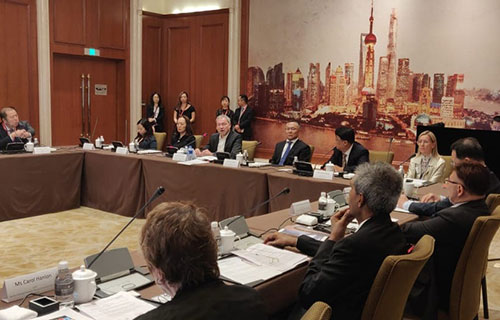"The Chinese textile industry has become a key player after decades of reform. In 2018, Chinese production of chemical fibers made up over two thirds of the global production. “Textile exports from the country also increased by 3.5 per cent to reach 37.6 per cent of the world’s total in 2018, while apparel exports accounted for 31.3 per cent of the total world’s total exports"
 Advanced manufacturing and additional investments in companies across the world, have made China the world’s biggest textile market. To exploit the growing potential of this market, the 25th Autumn Edition of Intertextile Shanghai Apparel Fabrics organised a private round table meeting on September 25, 2019. The conference included a keynote speech and a panel discussion. Olaf Schmidt, Vice President of Textiles & Technologies at Messe Frankfurt delivered the welcome speech. “Through this fair, we aim to curate a fringe programme that will inform, engage and connect thought leaders from across the world,” he said.
Advanced manufacturing and additional investments in companies across the world, have made China the world’s biggest textile market. To exploit the growing potential of this market, the 25th Autumn Edition of Intertextile Shanghai Apparel Fabrics organised a private round table meeting on September 25, 2019. The conference included a keynote speech and a panel discussion. Olaf Schmidt, Vice President of Textiles & Technologies at Messe Frankfurt delivered the welcome speech. “Through this fair, we aim to curate a fringe programme that will inform, engage and connect thought leaders from across the world,” he said.
Xu Yingxin, Vice President of the China National Textile and Apparel Council and Chairman of CCPIT-TEX (co-organiser of the fair) delivered the keynote address, titled: The Current Situation of China’s Textile Industry. The main takeaways from the keynote address and the panel discussion were:
High demand from the domestic market
The Chinese textile industry has become a key player after decades of reform. In 2018, Chinese production of chemical fibers made up over two thirds of the global production. “Textile exports from the country also increased by 3.5 per cent to reach 37.6 per cent of the world’s total in 2018, while apparel exports accounted for 31.3 per cent of the total world’s total exports,” noted Yingxin 
Although the purchasing power of Chinese consumers has slowed slightly, country’s textile industry is still experiencing high demand from the domestic market. “Our huge population offers our apparel industry a huge safety net as clothing is a necessity rather than a luxury,” Yingxin observed. However, though apparel sales have continued to grow in 2019, the pace of growth slowed.
Emphasis on creating a strong consumer economy
The panel discussion also focused the importance of a strong consumer economy in order to maintain high domestic purchasing power. Paul Alger, UK Fashion & Textile Association warned of the social consequences and lack of purchasing power caused due to a weak consumer economy. KV Srinivasan, TEXPROCIL indicated that India’s consumer economy benefits from their strength, including a rich textile heritage and skilled technical workforce.
Three missions to develop the textile industry
China’s textile investments in 2019 focused on technology and innovation, resulting in increased productivity. The Autumn edition of Intertextile Shanghai Apparel Fabrics noted three key missions for China’s progress including technology and innovation; culture and local talent; and sustainability.
The panel discussion further focused on sustainability. Carol Hanlon, Textile Clothing Footwear Resource Centre, Australia pointed out “As a leader of textile production, China has the capacity to drive change in circularity. There will be a demand for sustainability in the future as younger generations are increasingly associated with climate activism.”
Burgeoning investments strengthen manufacturing, increase co-operation
During the first five years of the Belt & Road initiative, total trade volume between China and other countries along the Belt & Road route exceeded $6 trillion, accounting for nearly a third of China’s total trade in goods during this period. By 2018, the country reportedly invested $6.5 billion in countries along the Belt & Road route. These investments offer a two-fold benefit to China. They build efficient manufacturing bases along the Belt & Road route besides increasing international co-operation to strengthen resources throughout the supply chain.
China creating opportunities for other countries
China exports around 18 per cent its textiles to the US. It is also the largest exporter of textiles and apparel to the US, accounting for 38 per cent of the nation’s total imports. This is creating new opportunities for other countries to explore the US market. Ade Sudrajat, Indonesian Textile Association noted, “We aim to develop our local e-commerce and start-ups.”
Autumn 2019 Edition of Intertextile Shanghai Apparel Fabrics was held from September 25-27, 2019 in Shanghai. The event was co-organised by Messe Frankfurt (HK) alongwith Sub-Council of Textile Industry, CCPIT; and the China Textile Information Centre.












